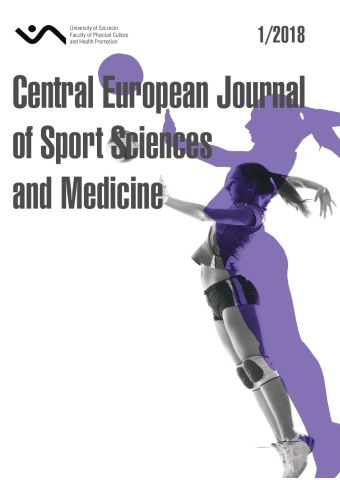
ISSN: 2300-9705
eISSN: 2353-2807
OAI
DOI: 10.18276/cej.2018.1-06




Issue archive /
Vol. 21, No. 1/2018
The Influence of Dancing Activities on Women's Self-Image
| Authors: |
Adrianna
Banio
Faculty of Physical Education and Health Promotion, University of Szczecin, Poland |
| Keywords: | dancing classes self-acceptance self-image self-awareness |
| Data publikacji całości: | 2018-03-30 |
| Page range: | 5 (49-53) |
Abstract
Dancing not only improves our development, but also changes us. It changes our attitude to many issues. It influences our temperament thus transforming the perception of our body.
The chief aim of this research was to prove that dancing classes are a form of work on reaching self-awareness and that they have therapeutic properties. The subjects were female participants of all kinds of dancing classes, conducted in various schools by different instructors. 51 females, aged 20 – 60 years old voluntarily participated in a diagnostic survey.
Dancing class participants, often unknowingly, undergo a certain metamorphosis. Indisputably, dancing has therapeutic influence; it allows to create and discover hitherto unknown recesses of ourselves.
Dancing classes considerably diminish our low self-esteem and distorted perception of our body. The analysis of research shows that behavior of women who participated in dancing class change so that they can more effectively fulfill their life aims.
Download file
Article file
Bibliography
| 1. | Adler, A. (1939). Sens życia. Kraków: Drukarnia Pospieszna. |
| 2. | Baley, S. (1947). Drogi samopoznania. Kraków: Wiedza, Zawód, Kultura. |
| 3. | Brezińska A. (1973). Sturktura obrazu własnej osoby I jej wpływu na zachowanie. Kwartalnik Pedagogiczny, 3, 87. |
| 4. | Brzezińska, A. (1973). Struktura obrazu własnej osoby i jego wpływ na zachowanie. Kwartalnik Pedagogiczny, 3, 87–97. |
| 5. | De Bruin, A.P., Oudejans, R.R.D., Bakker, F.C., Woertman, L. (2011). Contextual body image and athletes’ disordered eating: the contribution of athletic body image to disordered eating in high performance women athletes. European Eating Disorders Review, 3 (19). 201–215. |
| 6. | Fredrickson, B.L., Roberts T.-A. (1997). Objectification theory: toward understanding women’s lived experiences and mental health risks. Psychology of Women Quarterly, 2 (21), 173–206. |
| 7. | Gough, H.G., Heilbrun, A.B. (1983). The Adjective Check List Manual, 8. |
| 8. | Grogan, S. (2017) Body Image: Understanding Body Dissatisfaction in Men, Women and Children. New York: Routledge. |
| 9. | Hurlock, E.B. (1960). Rozwój dziecka. Warszawa: PWN. |
| 10. | James, W. (1890). The Principles of Psychology, 1. New York: Holt. |
| 11. | Kantanista, A., Glapa, A., Banio, A., Firek, W., Ingarden, A., Malchrowicz-Mośko, E., Markiewicz, P., Płoszaj, K., Ingarden, M., Maćkowiak, Z. (2018). Body image of highly trained female athletes engaged in different types of sport. BioMed Research International. |
| 12. | Konorski, J. (1969). Integracyjna działalność mózgu. Warszawa: PWN. |
| 13. | Kozielecki, J. (1986). Psychologiczna teoria samowiedzy. Warszawa: PWN. |
| 14. | Krane, V., Stiles-Shipley, J.A., Waldron, J., Michalenok, J. (2001). Relationships among body satisfaction, social physique anxiety, and eating behaviors in female athletes and exercisers. Journal of Sport Behavior, 3 (24). 247–265. |
| 15. | Krane, V., Stiles-Shipley, J.A., Waldron, J., Michalenok, J. (2001). Body image concerns in female exercisers and athletes: a feminist cultural studies perspective. Women in Sport and Physical Activity Journal, 1 (10). 17–54. |
| 16. | Loland, N.W. (1999). Some contradictions and tensions in elite sportsmen’s attitudes towords their bodies. International Review for the Sociology of Sport, 3 (34), 291–302. |
| 17. | Murphy, G. (1947). Personality. A Biosocial Approach to Origins and Structure. |
| 18. | Newcomb, T.M., Turner, R.H, Converse, P.E. (1970). Psychologia społeczna: stadium interakcji ludzkich. Warszawa: PWN. |
| 19. | Przetacznikowa, M. (1971). Rozwój i wychowanie dzieci i młodzieży w średnim wieku szkolnym. 257. Warszawa: Nasza Księgarnia. |
| 20. | Raimy, V. (1975). Misunderstanding of the Self. San Francisco: Jossey-Base. |
| 21. | Reel, J.J., Petrie, T.A., SooHoo, S., Anderson, C.M. (2013). Weight pressures in sport: Examining the factor structure and incremental validity of the weight pressures in sport – females. Eating Behaviors, 2 (14), 137–144. |
| 22. | Reykowski, J. (1970). Obraz własnej osoby jako mechanizm regulujący postępowanie. Kwartalnik Pedagogiczny, 3, 45–58. |
| 23. | Rogers, C.R. (1959). A Theory of Therapy, Personality, and Interpersonal Relationships As Developed in the Client-Centered Framework. In: S. Koch (ed.), Psychology A Study of a Science. Formulations of the Person and the Social Context (vol. 3, pp. 184–256). New York: McGraw Hill. |
| 24. | Siek, S. (1993). Wybrane metody badania osobowości. Warszawa: Wydawnictwo Akademii Teologii Katolickiej. |
| 25. | Snygg, D., Combs, A. (1959). Indywidual Behavior. A Perceptual Approach to Behavior. New York: Harper. |
| 26. | Szymanski, D.M., Moffitt L.B., Carr E.R. (2011). Sexual objectification of women: advances to theory and research 1ψ7. The Counseling Psychologist, 1 (39), 6–38. |
| 27. | Thompson, R.A., Sherman, R.T. (2010). Eating Disorders in Sport. New York: Routledge. |
| 28. | Wylie, R. (1961). The Self Concept, a Critical Survey of Pertinent Research Literature. Lincoln: University of Nebraska Press. |
| 29. | Zaborowski, Z. (1967). Psychologia społeczna a wychowanie. Warszawa: Państwowe Zakłady Wydawnictw Szkolnych. |